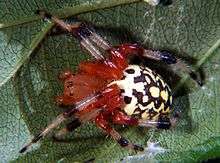Araneus marmoreus
| Araneus marmoreus | |
|---|---|
 | |
| Araneus m. marmoreus (nominate) | |
| Scientific classification | |
| Kingdom: | Animalia |
| Phylum: | Arthropoda |
| Subphylum: | Chelicerata |
| Class: | Arachnida |
| Order: | Araneae |
| Infraorder: | Araneomorphae |
| Family: | Araneidae |
| Tribe: | Araneini |
| Genus: | Araneus |
| Species: | A. marmoreus |
| Binomial name | |
| Araneus marmoreus Clerck, 1757[1] | |
Araneus marmoreus, commonly called the marbled orb-weaver, is a species of spider belonging to the family Araneidae. It has a Holarctic distribution.
Araneus marmoreus is found throughout all of Canada to Alaska, the northern Rockies, from North Dakota to Texas, and then east to the Atlantic, as well as in Europe. It is one of the showiest orbweavers.
Two main forms of this species are known. The nominate variety has an orange abdomen with black or brown marbling while var. pyramidatus is much paler, sometimes almost white, with a single dark blotch towards the rear of the abdomen. The nominate variety is found throughout the species' range while var. pyramidatus is found only in Europe, where the two varieties are seldom found together. The female has a body length (excluding legs) of up to 14 mm while the male is rather smaller at 9 mm.

Adult female marbled orbweavers are 9 to 20 millimeters in length with very large abdomens that are mostly orange with brown to purple markings and spots of pale yellow. Occasionally the abdomens are nearly white in color. The cephalothorax is yellow to burnt-orange with a central dark line and dark lines down either side. The femora and patellae are orange. The other leg segments are yellow, becoming brown at the distal ends, as are all of the legs of the males.
The webs are found in trees, shrubs and tall weeds, and grasses in moist, wooded settings and can frequently be found along the banks of streams. The webs are oriented vertically and have a "signal" thread attached to the center that notifies the spider when prey has been captured. Unlike Argiope garden spiders, Araneus marmoreus hides in a silken retreat to the side of the web (at the end of the signal thread). In adults, the retreat is made of leaves folded over and held together with silk. Immature spiders make their retreats out of silk only.
Egg cocoons, which contain several hundred eggs, are generally deposited in October and are constructed of white silk formed in a flattened sphere. Immature spiders emerge from the cocoons in spring. Adults are seen from midsummer until the first hard freeze of fall.
Like other orbweavers, the marbled orbweaver is not considered a medically important species.
References
- ↑ "Taxon details Araneus marmoreus Clerck, 1757". World Spider Catalog. Natural History Museum Bern. Retrieved 2016-10-03.
- Preston-Mafham, Ken (1998). Spiders: Compact Study Guide and Identifier. Angus Books. ISBN 978-1-904594-93-2.
| Wikimedia Commons has media related to Araneus marmoreus. |